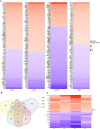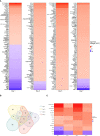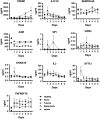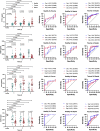Identifying biomarkers deciphering sepsis from trauma-induced sterile inflammation and trauma-induced sepsis
- PMID: 38283341
- PMCID: PMC10820703
- DOI: 10.3389/fimmu.2023.1310271
Identifying biomarkers deciphering sepsis from trauma-induced sterile inflammation and trauma-induced sepsis
Abstract
Objective: The purpose of this study was to identify a panel of biomarkers for distinguishing early stage sepsis patients from non-infected trauma patients.
Background: Accurate differentiation between trauma-induced sterile inflammation and real infective sepsis poses a complex life-threatening medical challenge because of their common symptoms albeit diverging clinical implications, namely different therapies. The timely and accurate identification of sepsis in trauma patients is therefore vital to ensure prompt and tailored medical interventions (provision of adequate antimicrobial agents and if possible eradication of infective foci) that can ultimately lead to improved therapeutic management and patient outcome. The adequate withholding of antimicrobials in trauma patients without sepsis is also important in aspects of both patient and environmental perspective.
Methods: In this proof-of-concept study, we employed advanced technologies, including Matrix-Assisted Laser Desorption/Ionization (MALDI) and multiplex antibody arrays (MAA) to identify a panel of biomarkers distinguishing actual sepsis from trauma-induced sterile inflammation.
Results: By comparing patient groups (controls, infected and non-infected trauma and septic shock patients under mechanical ventilation) at different time points, we uncovered distinct protein patterns associated with early trauma-induced sterile inflammation on the one hand and sepsis on the other hand. SYT13 and IL1F10 emerged as potential early sepsis biomarkers, while reduced levels of A2M were indicative of both trauma-induced inflammation and sepsis conditions. Additionally, higher levels of TREM1 were associated at a later stage in trauma patients. Furthermore, enrichment analyses revealed differences in the inflammatory response between trauma-induced inflammation and sepsis, with proteins related to complement and coagulation cascades being elevated whereas proteins relevant to focal adhesion were diminished in sepsis.
Conclusions: Our findings, therefore, suggest that a combination of biomarkers is needed for the development of novel diagnostic approaches deciphering trauma-induced sterile inflammation from actual infective sepsis.
Keywords: A2M; IL1F10; SYT13; bacteremia; biomarkers; sepsis; systemic inflammatory response syndrome; trauma.
Copyright © 2024 Papareddy, Selle, Partouche, Legros, Rieu, Olinder, Ryden, Bartakova, Holub, Jung, Pottecher and Herwald.
Conflict of interest statement
The authors declare that the research was conducted in the absence of any commercial or financial relationships that could be construed as a potential conflict of interest. The author(s) declared that they were an editorial board member of Frontiers, at the time of submission. This had no impact on the peer review process and the final decision.
Figures






References
Publication types
MeSH terms
Substances
LinkOut - more resources
Full Text Sources
Medical
Miscellaneous

